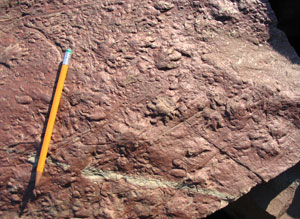 |
Ancient reptiles conquer continental interiors. (© James Robins Illustration) |
Some 315 million years ago, a reptile about the size of house cat took a walk along a dried up river bed, leaving its small, splayed footprints behind.
A few small steps for an ancient tetrapod, one huge step for science. Turns out that was some walk -- providing evidence that early reptiles were the first vertebrates able to live on dry river plains far from the sea. Meanwhile, their amphibian cousins were still hanging out “poolside,” needing the wetter environment to breed, lay their eggs and reproduce.
| ||
| ||
|
“This is a major evolutionary development -- allowing our ancestors to live on land without having to beetle back to the water to reproduce,” explains Martin Gibling, professor of Earth sciences and a co-author of a paper just published in journal Palaeogeography, Palaeoclimatology, Palaeoecology.
By “our ancestors” Dr. Gibling clarifies: “Meaning vertebrates, from fish through amphibians to reptiles to birds, then through to us, mammals ... It’s a major step that allows larger animals to populate the land.”
The reptile trackways preserved in rock were literally stumbled upon by the paper’s lead author, Howard Falcon-Lang of Royal Holloway, University of London, who grazed his knee as he scrambled over the fossilized slab. The rock -- “about the size of a filing cabinet,” says Dr. Gibling -- had fallen out of a sea-cliff along the Bay of Fundy, near the town of St. Martins on New Brunswick’s southern coast.
The tracks are abundant and indicate a few different kinds of reptiles were there, including one with slender digits and a narrow splay and another with a much stubbier foot. Also recorded in the rock are the mud cracks of a dry riverbed, the pitter-patter of raindrops and various plants.
It was Arden Bashforth’s job to examine that plant. He determined there were big, seed-bearing trees nearby that would have lived in a dry landscape.
The paper’s publication caps off his time at Dalhousie nicely; he just defended his PhD thesis on paleoecology (the study of fossil organisms and their relationship to ancient environments) and is returning to Denmark where he just landed a job at a geological museum in Copenhagen.
READ: "Diverse tetrapod trackways in the Lower Pennsylvanian Tynemouth Creek Formation, southern New Brunswick, Canada" (PDF) by Howard J. Falcon-Lang, Martin R. Gibling, Michael J. Benton, Randall Miller and Arden R. Bashforth. Palaeogeography, Palaeoclimatology, Palaeoecology, 2010.



